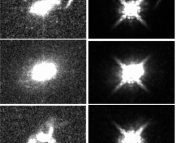Title: A dusty compact object bridging galaxies and quasars at cosmic dawn
Authors: S. Fujimoto, G. B. Brammer, D. Watson, et al.
First Author’s Institution: Cosmic Dawn Center (DAWN), Copenhagen, Denmark; Niels Bohr Institute, University of Copenhagen, Copenhagen, Denmark
Status: Published in Nature [closed access]
In human evolution, the term ‘missing link’ is often employed to describe a discovered fossil that helps connect hominid ancestors to modern humans. These fossils help identify a transitional stage and shed light on the evolutionary puzzle that is human development. Today’s paper tackles the very same problem, just with a slightly different subject – quasars.
Baby Quasars
Quasars – a portmanteau of the term quasi-stellar objects – are a class of extremely high luminosity objects known as active galactic nuclei, believed to be powered by accretion onto a supermassive black hole (SMBH). With masses on the order of millions of times the mass of our Sun, these are some of the most energetic sources of radiation in the universe. However, the origin story for these objects is still an open question. Observations have identified quasars as early as a billion years after the Big Bang (around a redshift of 6, speaking in cosmological terms; for reference, the Universe is now roughly 13.8 billion years old). While this may seem like a long time, cosmologically speaking, models struggle to explain how such objects could come to grow to their observed masses so rapidly. Various models describe the growth of supermassive black holes in the early Universe in different ways, but it is difficult to rule these models out without observations of such black holes at different stages of their evolution. Today’s authors report a discovery that they hope does just that – they believe they have identified a quasar in an early stage in its evolution, just 700 million years after the Big Bang!
The first step is to confirm that this object – catchily named GNz7q – is indeed a quasar as they hope. Using data from the Hubble Space Telescope, the authors analyzed the spectrum of GNz7q (see Figure 1), observing a sharp decline in the flux at wavelengths smaller than 1 micron. Such a feature is best described by a break in the spectrum known as the Lyman-alpha break, at 1216 Angstroms (roughly 1 micron). At energies higher than this Lyman break (equivalently, wavelengths smaller than the break), the photons emitted are sufficiently energetic to excite an electron transition in hydrogen atoms in the surrounding medium and will be absorbed by the surrounding neutral gas. As a result, we see a characteristic feature wherein there is no flux below this limit and strong flux above. Because this limit occurs at a well understood point in the spectrum, the authors use this to determine the redshift of the object, placing GNz7q at a redshift of z = 7.1899. Then, comparing other characteristics of the spectrum – such as the UV continuum slope – to what is observed for red quasars at lower redshift, they believe that GNz7q is likely a quasar.
However, upon further examination of the spectrum, and follow up observations of the object with other instruments, they notice that, puzzlingly, GNz7q emits only faintly in the X-ray and lacks the strong ultraviolet (UV) lines we expect of a quasar. They argue that these observations suggest that the object may not be a full fledged quasar quite yet – positing that this may instead be a compact star forming object on its way to becoming a quasar. Fitting the spectral energy distribution (SED) of the object (a plot of the energy-versus-wavelength; see Figure 2), they estimate an infrared luminosity that corresponds to star formation at a rate of roughly 1500 times the mass of the Sun per year (for reference, the Milky Way’s star formation rate (SFR) is estimated at a measly 1 solar mass per year). In fact, they find that this object is forming stars so vigorously that it is at the Eddington limit for star formation in galaxies – any more and the radiation pressure from the stars would overcome the gravitational force and eject gas from the galaxy, suppressing further star formation! This SFR, combined with the observed spectral features, leads the authors to conclude that the most likely identification for GNz7q is a red quasar, a class of objects believed to be in an early transition stage in galaxy evolution.
So What Does This Mean?
To sum up the conclusions thus far, the authors describe that GNz7q is “a low-luminosity, dust-obscured quasar emerging in a vigorously star-bursting host”, which falls in line with some models for high redshift quasar formation. These models spin a dynamic tale of quasar formation. Gas in galaxies collapses to form stars, which ultimately end their lives as supernovae. The feedback from these massive explosions drives gas into the nascent black hole at the center of the galaxy, accelerating its growth and setting the stage for the formation of what we come to observe as a quasar.
While such objects have been observed before, this potential observation is nearly 500 million years earlier in the Universe’s history than any similar observation. Because it emits so faintly in the X-ray and has such a high SFR in its host, the authors theorize that GNz7q must be in a very early stage of its evolution. To try and understand what might be in store for such an object – i.e. to guess how it might evolve – the authors compare their observational results to cosmological models for progenitors of quasars in the early Universe. These models predict that quasars with similar properties to GNz7q would have less massive than average SMBHs but be present in more massive than average dark matter halos – which is right in line with the estimated black hole mass of this source. Excitingly, the observation of this source at such a high redshift – where we did not expect to find them – suggests that these quasars may be more common than we think and may have already been observed – but overlooked – in existing data.
In any case, follow up observation of this object with forthcoming instruments, such as the JWST, will shed more light on some of the conclusions drawn in this paper and will help reinforce our understanding of how these quasars came to be.
Astrobite edited by Clarissa Do-o
Featured image credit: adapted from IMDB




